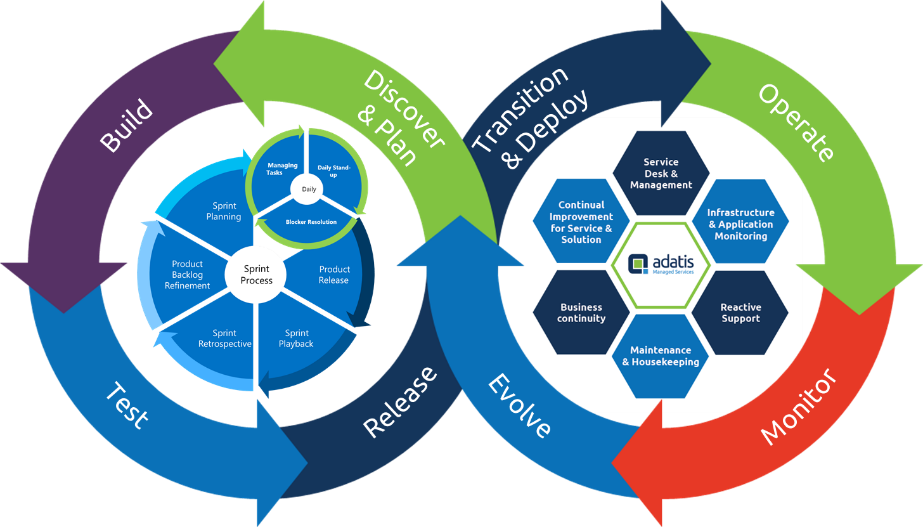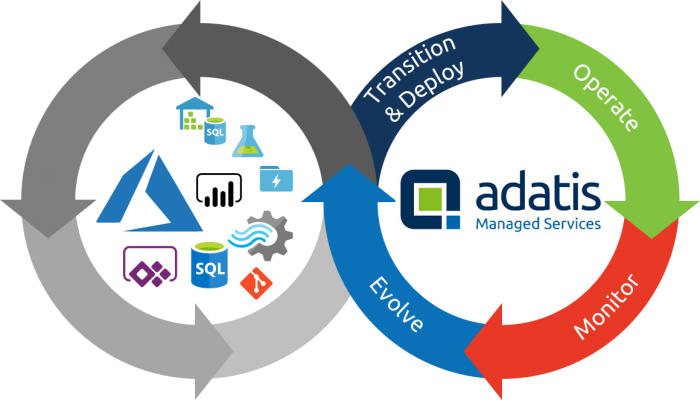As more organisations embrace and adopt a DevOps model for application delivery, it is becoming more common place to assume a similar model and toolchain for data analytics.
At Adatis, this model has become embedded across our own development and operation. Defining and adopting the right processes, methods, technologies and tooling for data analytics solutions. These will continue to evolve, as we evaluate how we can improve, and how the technologies and tools we use can further simplify things. However, we are now reaping the benefits of being able to be more agile, without compromising on quality across the full lifecycle.
It is essential the model is flexible. When we work with organisations, we are commonly integrating their capabilities into one or more aspects of the DevOps cycle, with every environment being different. Also, over time different elements of the cycle are stretched with a changing focus as delivery and adoption continues.
Within Adatis delivery, the development cycle has been categorised into 4 key elements, based around the adoption of SCRUM: Discover & Plan; Build; Test; and Release. Adatis has a very well-established Discovery engagement to minimise risk with subsequent delivery cycles by performing just enough up-front design, and then drilling down into this with each cycle. The build includes the configuration of CI/CD pipelines and emphasis is placed on test automation as a part of the adopted quality framework. Finally, with user acceptance, the release is packaged and transitioned ready for deployment and operation.
The Adatis Managed Service can be tailored to provide an operation that will seamlessly link in with your Data Analytics development cycle, whether delivered internally or by an external partner including our colleagues in Adatis delivery. Meaning that you can focus on forging Data Analytics ahead in your organisation. While Adatis Managed Services ensure the production service is operating efficiently and enabling business value.
We’ve distilled the operation down to 4 elements:
- Transition & Deploy – Regular release cycle transition into service including knowledge transfer and deployments.
- Operate – Comprehensive operational management including, reactive support, user data & configuration requests.
- Monitor – Solution monitoring including availability, data processing and reconciliation, Azure consumption and performance.
- Evolve – Continual improvement & small works such as analytics managed in parallel to the development cycle which may then focus on data acquisition.
Our standard Service Plans which provide guidance on the services we deliver, align to our DevOps model:
The Essential service is ideal for organisations who have established their own end-to-end operation but would like the reassurance of a specialised data analytics service, that will respond on demand. Providing support across any of the operation elements.
Our Established service is aimed at those organisations who are looking for an external partner to take care of the day to day operation. But they may have some elements of an operation in place to integrate and possibly establish further over time. The Established service provides a proactive service covering all 4 elements of operation, with a provision for a regular planned release cycle.
Finally, our Enterprise service can take care of all your operation needs as a fully-inclusive service, with the ability to scale to 24|7.
All the Service Plans can be extended to provide support across the development cycle, if required and include our Microsoft Cloud Solution Provider services.
If you’d like to learn more about how our Operations for Data Analytics service is completing the DevOps cycle, we’d love to chat. Talk to one of our friendly experts today by dropping an email at enquiries@adatis.co.uk.
And look out for the follow up blog, in which I’ll be discussing how Adatis can support you in establishing your own operation capability for data analytics.




Introduction to Data Wrangler in Microsoft Fabric
What is Data Wrangler? A key selling point of Microsoft Fabric is the Data Science
Jul
Autogen Power BI Model in Tabular Editor
In the realm of business intelligence, Power BI has emerged as a powerful tool for
Jul
Microsoft Healthcare Accelerator for Fabric
Microsoft released the Healthcare Data Solutions in Microsoft Fabric in Q1 2024. It was introduced
Jul
Unlock the Power of Colour: Make Your Power BI Reports Pop
Colour is a powerful visual tool that can enhance the appeal and readability of your
Jul
Python vs. PySpark: Navigating Data Analytics in Databricks – Part 2
Part 2: Exploring Advanced Functionalities in Databricks Welcome back to our Databricks journey! In this
May
GPT-4 with Vision vs Custom Vision in Anomaly Detection
Businesses today are generating data at an unprecedented rate. Automated processing of data is essential
May
Exploring DALL·E Capabilities
What is DALL·E? DALL·E is text-to-image generation system developed by OpenAI using deep learning methodologies.
May
Using Copilot Studio to Develop a HR Policy Bot
The next addition to Microsoft’s generative AI and large language model tools is Microsoft Copilot
Apr